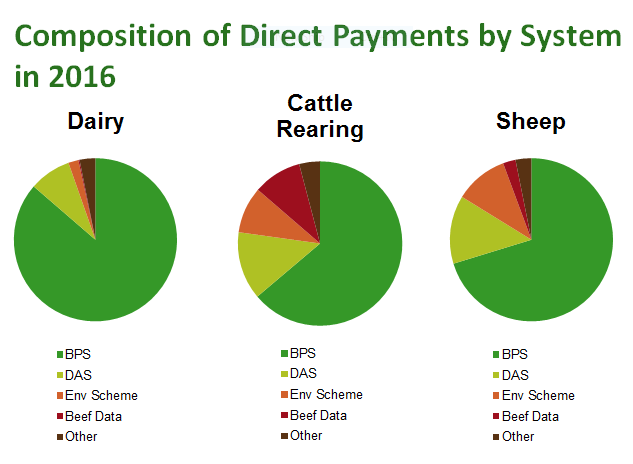The average direct payment was €17,932 in 2016, accounting for 75% of farm income, a preliminary estimate from Teagasc’s National Farm Survey shows.
Cattle-rearing and sheep farms, on average, are 100% reliant on direct payments; even to the extent that negative market income is eating into direct payments received.
Market income (income before direct payments) on drystock farms was less than zero; indicating that, on average, these farms do not make a profit from production.
With dairy being the only exception, farm income across the board continues to be highly reliant on direct payments.
Contribution to income across farm systems
Dairy enterprises received an average direct payment of €19,397, which contributed 37% to farm income. Dairy farms remained the most profitable system with an average income of €51,809, the preliminary results of the National Farm Survey revealed.
Sheep enterprises were also found to be heavily reliant on support payments, with the average payment of €17,726 contributing 111% to farm income.
Other cattle enterprises – ‘cattle other’ – were just under 100% reliant, at 99%. The average direct payment was €16,694.
Tillage farms were in receipt of the highest direct payments, at €19,397. This is driven largely by their larger farm size. Many tillage farms would also have a large on-farm cattle enterprise. Direct payments made up 85% of farm income.
Direct payment breakdown
Direct payments increased 4% in 2016, mainly due to additional payments under the Basic Payment Scheme (BPS) which had been withheld in 2015. In addition, an increased number of payments were made under the Beef Data Genomics Scheme (BDGP) and the Green, Low-Carbon, Agri-Environment Scheme (GLAS) in 2016.
Direct payments comprised mainly of the BPS, with approximately €13,000 of the average direct payment coming from the scheme.
2016 saw an increase of 65% in payments under environmental schemes, such as GLAS and AEOS.
Pillar 1 payments made up the majority of direct payments for dairy systems. Whereas, in drystock systems, pillar 2 payments which include, for example, environmental schemes and the BDGP contributed a higher percentage compared to dairy.


